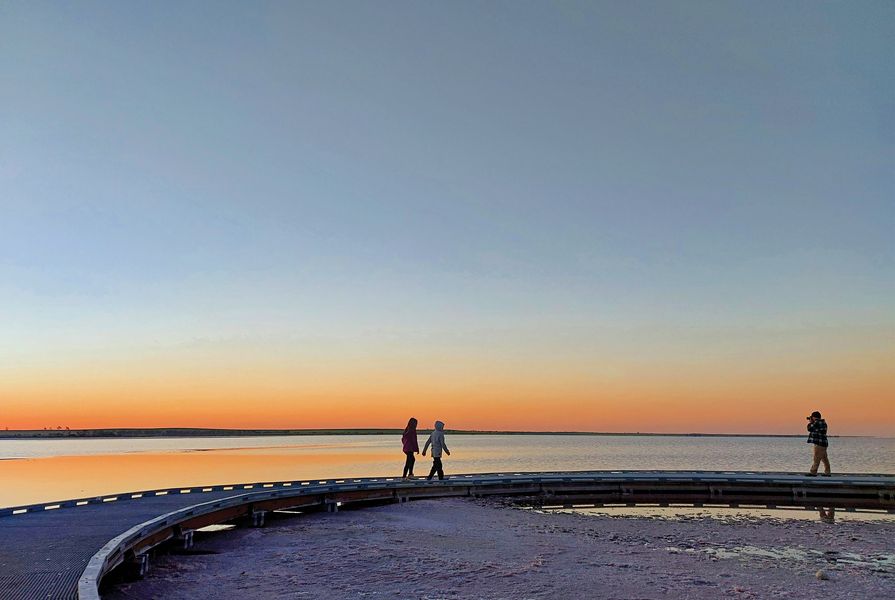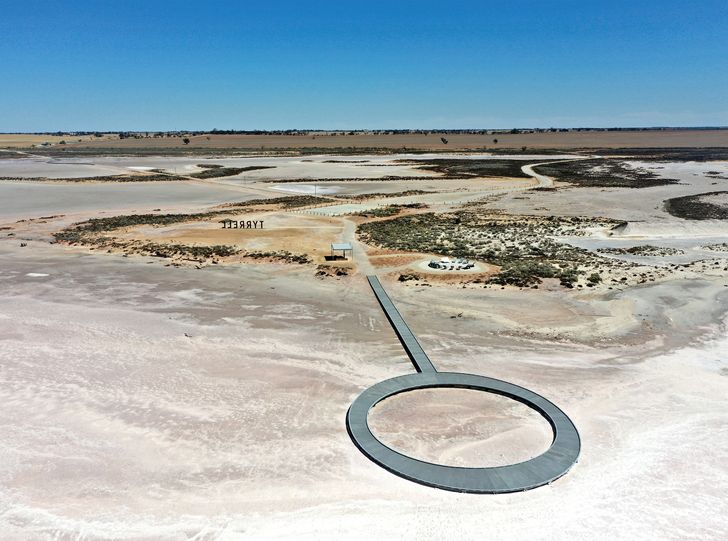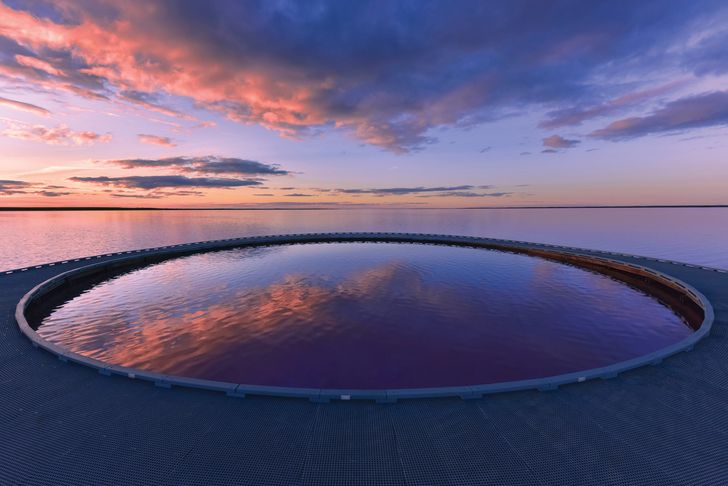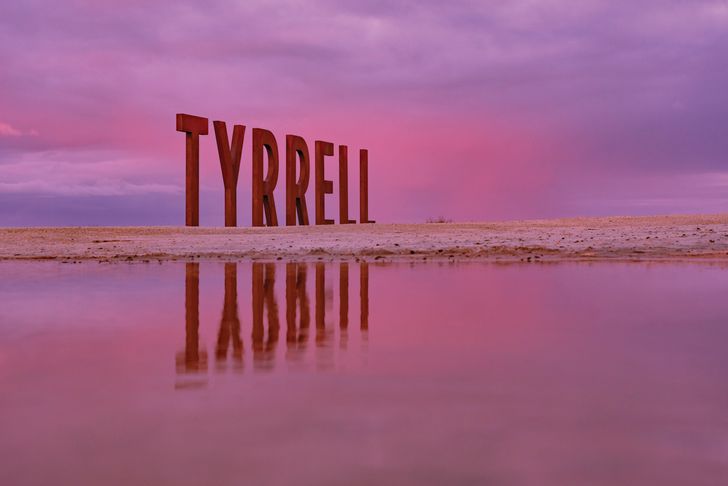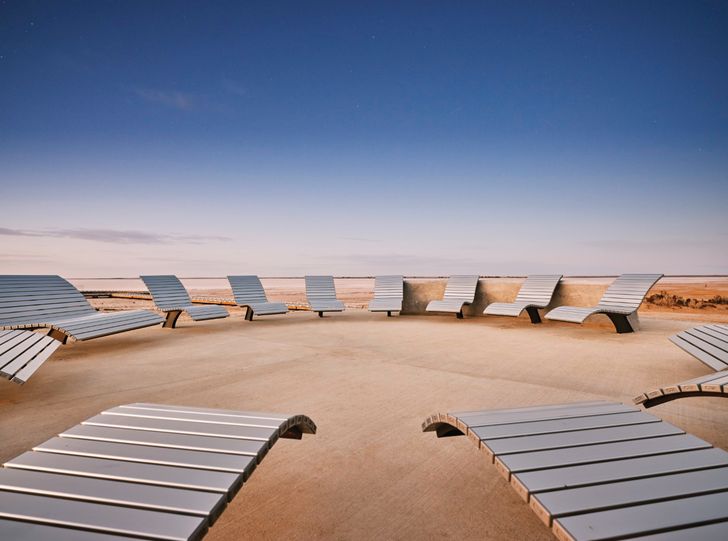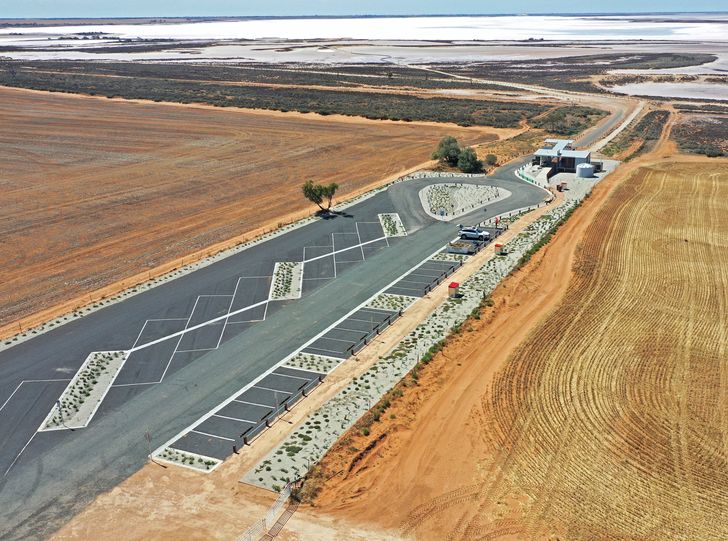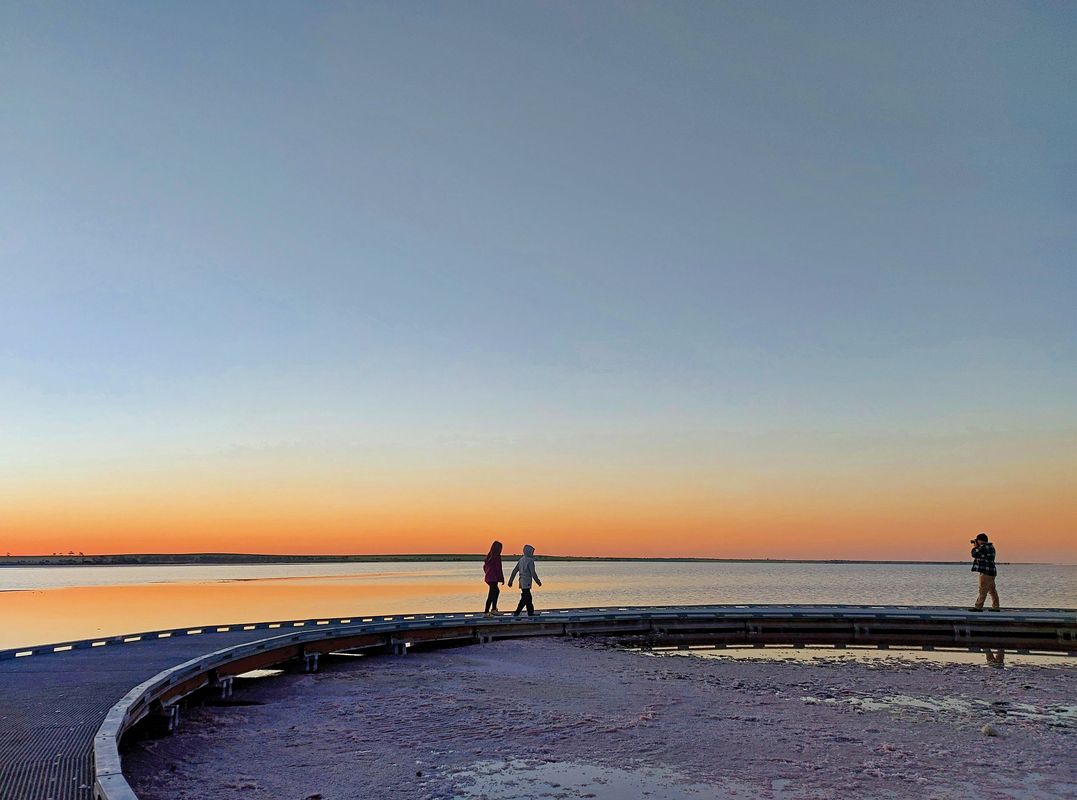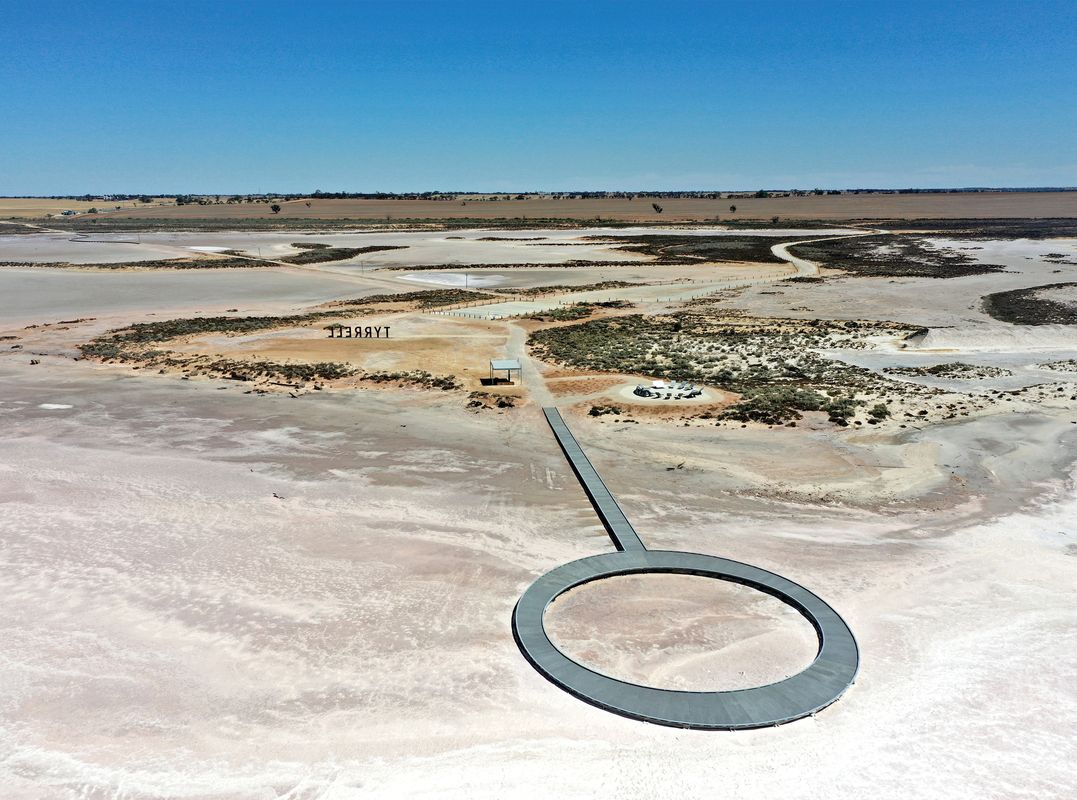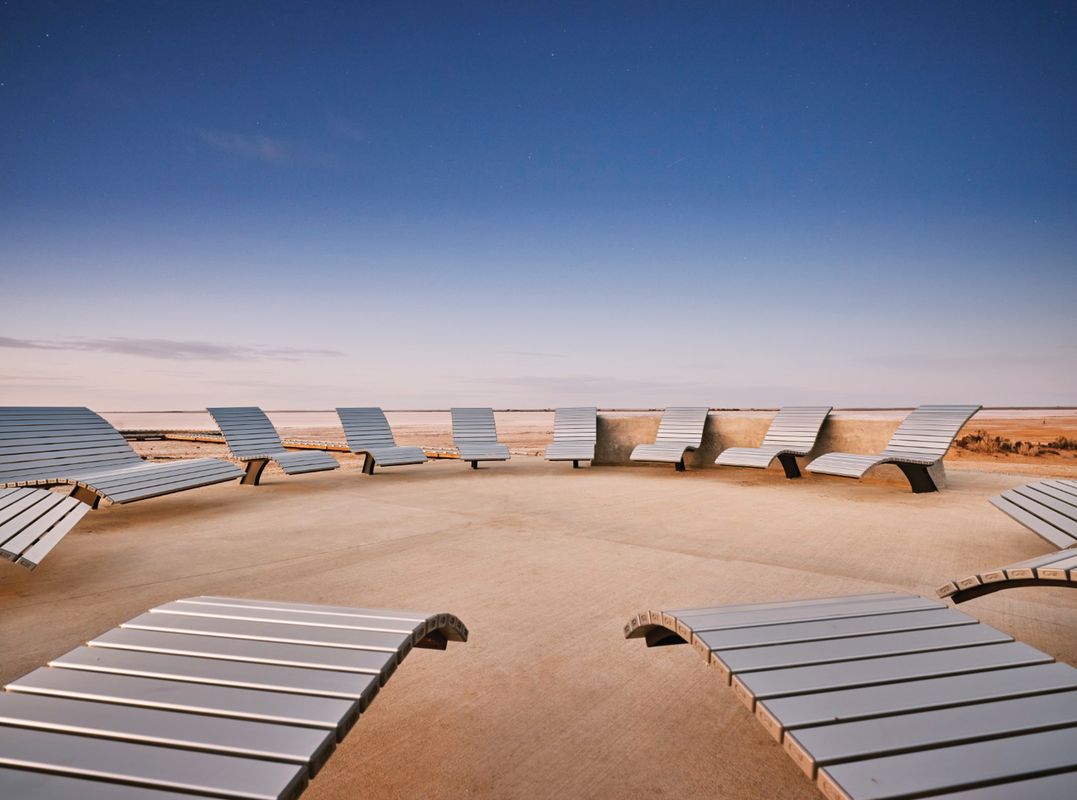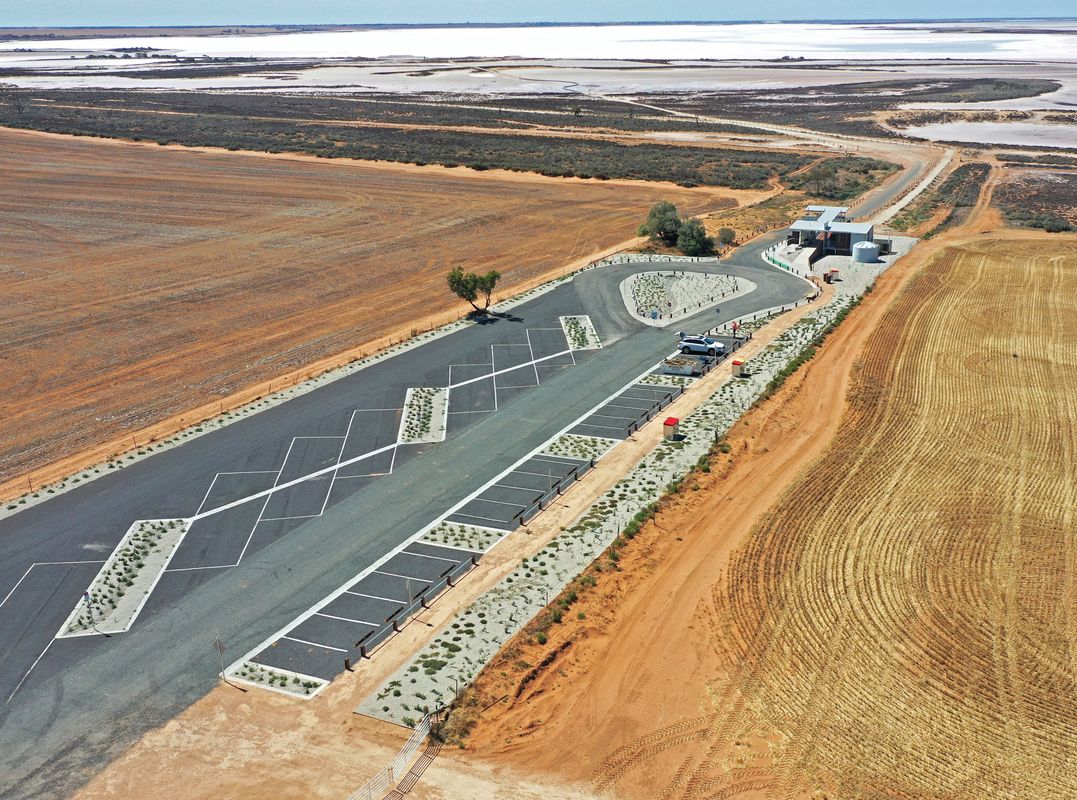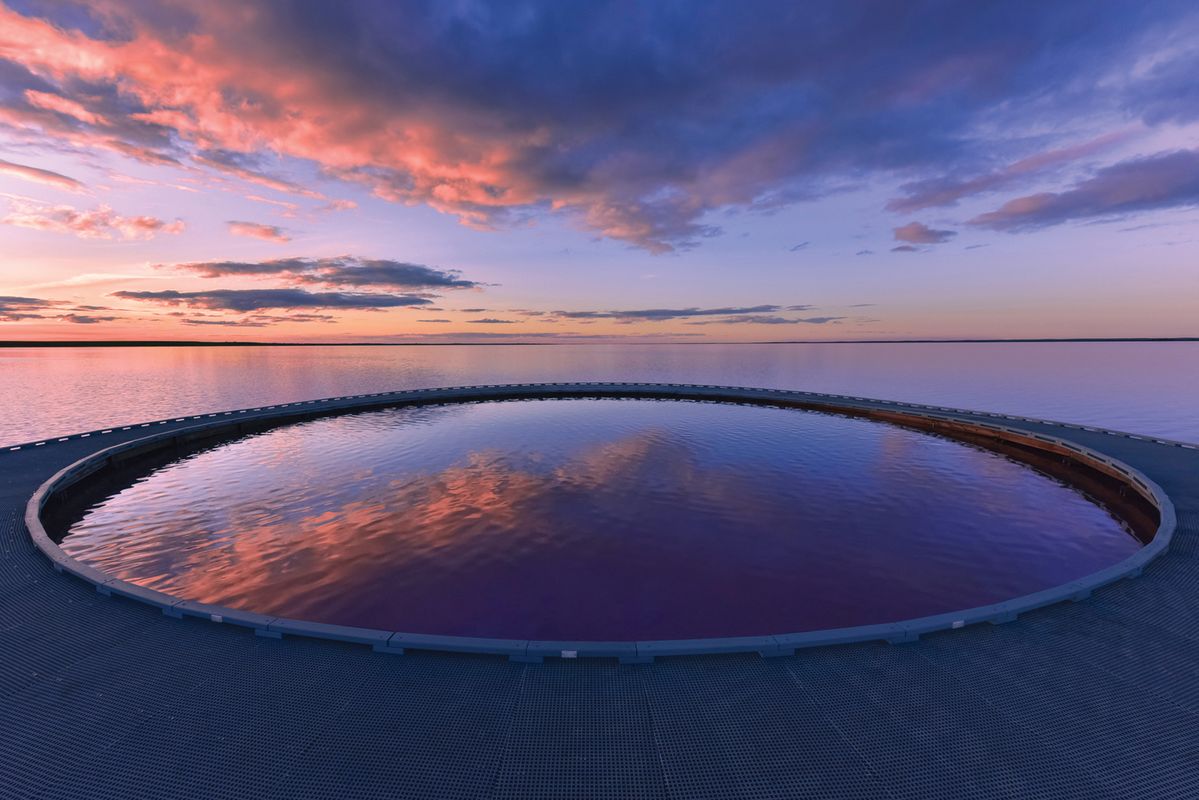On receiving an invitation to review this project my first action was to look it up online. The striking imagery of a pink mirage-like scene that popped straight up made me accept the invitation, thinking, almost without thinking, “I would love to see that!” This series of events – hearing of something and then looking it up on the internet – is not an unusual activity; so much modern activity is structured or aided by digital information. But this project’s specific location and the constructed landscape that it comprises have a particularly strong link to the viewing and styling practices precipitated by visual social media in the framing of the story about the project’s development.
My first response to the photographs was to the lake’s unusual and subtle colour palette and to the effects of mirroring that are a characteristic of this highly salt-laden water body at certain times of the year. The combination of these features with the clear geometries of the boardwalk and other constructed elements heightens the sense of drama and works to powerful effect within the limited canvas of the tiny mobile screen.
The interventions that comprise the Lake Tyrrell Visitor Tourism Infrastructure Design draw attention to the evolving interdependence of landscape and social media.
Image: David Hay
The potted version in online descriptions of the story of the establishment of this project is that a local posted images of the lake’s remarkable mirroring effects (most pronounced in winter, when the water levels are higher) on social media. The social media posts went viral in China, stimulating a visitor influx that overwhelmed the site’s limited access, caused damage to the sensitive environment, coated motel rooms with mud – the thick, sticky dark pungent mud that lies beneath the delicate pale pink salt crystals – and incited the frustration and displeasure of motel owners. (Anti-mud sentiments are still visibly expressed in the wider visitor accommodation landscape). To prevent damage to the site yet enable people to come and engage with the lake and the local economy, the program of information centre, parking, toilets, boardwalk to and onto the lake, sign and viewing seats was devised by the clients and developed by Thomson Hay Landscape Architects.
The AILA award citation for the project notes that it provides “safety and comfort while protecting the fragile environment” and “offers interpretation and that much sought-after Instagram moment.” Social media – and Instagram in particular– are frequently invoked as signifiers of self-regarding shallowness and artificially enhanced conventional physical beauty; they have also been associated with people taking dangerous and sometimes fatal risks to capture photos of themselves in particular landscape settings. Yet, Instagram’s initial popularity was in part allied to a combination of colour palette and format that lent itself to a type of landscape imagery commonly associated with distance and nostalgia. At the same time, Instagram provides a distinctively visual platform where designers and makers can post their design journeys, explorations and preferences and share their insights and experiments with a broader community.
In winter, water levels are highest, so the spectacular mirroring effect of the lake’s surface is most pronounced.
Image: Anne Morley
Near the edge of the lake, large corten steel structures spell “TYRRELL” in letters far taller than a human.
Image: Anne Morley
Travelling to visit the project was itself rewarding and immersive; driving six hours through the increasingly wide and dry landscape of the Mallee, north of Melbourne, lifted the expectation of drama. The arrival sequence at the elevated carpark helped me orientate myself with the components of the infrastructure, such as the visitors’ centre and lookout, and also introduced some of the Indigenous stories of this landscape through text and imagery. From this vantage point the distinctively shaped boardwalk (a circle on a prong) and sky-viewing circle are clearly visible, drawn into view by the connecting walking path down to the water’s edge. The other elements visible as part of the infrastructure are a small shelter by the lake and a very large corten steel structure that spells out TYRRELL in letters far taller than a human. This sign was not unexpected – it was visible in many online images of the site – but somehow it was disconcerting to encounter it as a three-dimensional feature in the landscape itself.
Some of the most photogenic effects of the mirroring are apparently most frequently seen in the winter months when water levels are elevated. I visited in summer at three different times of day: mid-afternoon, dusk and sunrise. From these visits, it appeared to me that the infrastructure does indeed direct and coordinate collective and individual movement of people and vehicles. At the time of visiting, the boardwalks seemed to limit forays into the more delicate parts of the lake shore ecosystems, though dark footprints showed that some visitors were still treading off the paths and sinking through the delicate pink crystal salt into the mud. The circular walkway, while quite small in dimension, repaid repeated circumnavigation. It allows movement across a gradation of salt of amazing subtlety and beauty.
The circle of reclining viewing chairs did create convivial gatherings of people looking upwards at the starry sky, though I found the profile very unergonomic for my own spine. The configuration of the chairs and the interpretive information embedded in the signage draws attention to Indigenous values in this landscape; overall, the visitor infrastructure overall seems to have been designed to expand not only access and view, but also awareness and understanding.
A circle of reclining viewing chairs encourages night-sky gazing, immersing visitors in their surrounds.
Image: Street Furniture Australia
The arrival sequence at the site guides visitors from the elevated carpark through to the visitors’ centre and lookout.
Image: David Hay
The notion of infrastructure engages the idea of a range of physical and conceptual elements that are purposely combined, configured and connected with the aim of achieving a certain function. Landscape architecture has engaged with the concepts of blue and green infrastructure to recognize how natural systems can be engaged around dynamic processes and vital systems, such as water, whose management was previously co-opted by static forms of built infrastructure. As a conceptual and physical framework, the notion of infrastructure has also been applied to processes of visiting and of viewing, and of visiting specifically in order to view particular landscape effects.
Further, sites for viewing landscapes have a long tradition in landscape architecture, with the framing of many of these sites tied to the formal principles of the sublime, picturesque and beautiful. This tradition continues to be expressed and expanded upon as the physical and conceptual apparatuses of viewing are embedded within the evolution of the discipline and profession; viewing structures and signage are devices deployed across many different types of landscape. Yet, when I visited Lake Tyrrell, I felt that the large steel letters struck an odd note. What was it that made me feel awkward about this sign?
It took me a long time to articulate what I thought and felt about this aspect of the design, which had a significant influence on my impressions of the landscape as a whole. I felt that the sign pushed me out of the experience of the landscape itself, making me self-conscious of the process of visiting and recording my visit for the purposes of making my own presence in the landscape. Part of what I found unsettling about this experience was that it seemed so closely aligned with a particular mode of viewing – through and for the screen. My conclusion is that, for me, this created a kind of anti-sublime experience. Instead of being roused by the overwhelming grandeur of nature or the pleasurable sense of danger while remaining safe, I was exhorted by this giant sign to embrace a form of heightened self(ie) consciousness.
As infrastructure for visitors, this project does what it says on the tin, but the ingredients are more complex than might at first appear. Visiting any landscape is bound up with the anticipation and reputation of place, gained through various forms of media, as well as professional and personal connections. The forms and interventions that make up the Lake Tyrrell Visitor Tourism Infrastructure Design are tied into and draw valid attention to the evolving interdependence of landscape and social media as social constructs. They also give access to a unique and mesmerizing landscape of wonder and subtle power.
Credits
- Project
- Lake Tyrrell Tourism Infrastructure Design
- Design practice
- Thomson Hay Landscape Architects
Vic, Australia
- Project Team
- David Hay, Heidi Mikulic, Yolanda Li
- Consultants
-
Architectural design and documentation (Baileys Road visitor amenities and viewing deck)
Mortun Dunn Architects
Building and civil contractor Gradian Projects
Civil and structural engineer Cardno TGM (now Stantec)
Electrical and mechanical consultant Connor Pincus Group
Land surveyor Cardno TGM (now Stantec)
Quantity surveyor M.P. Cordia
Signage designer Challis Design
- Aboriginal Nation
- Built on the land of the Wergaia peoples (Boorong clan)
- Site Details
- Project Details
-
Status
Built
Design, documentation 24 months
Construction 12 months
Category Public / cultural
Type Tourism
- Client
-
Client name
Buloke Shire Council
Source
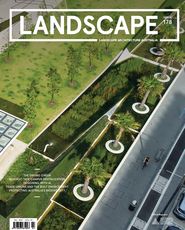
Review
Published online: 27 Jul 2023
Words:
Katrina Simon
Images:
Anne Morley,
Claire Reynolds,
David Hay,
Street Furniture Australia
Issue
Landscape Architecture Australia, May 2023

